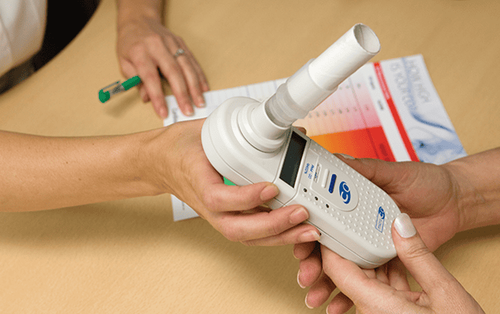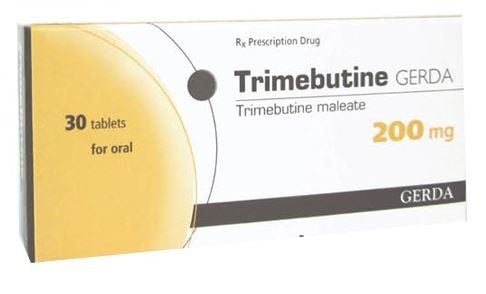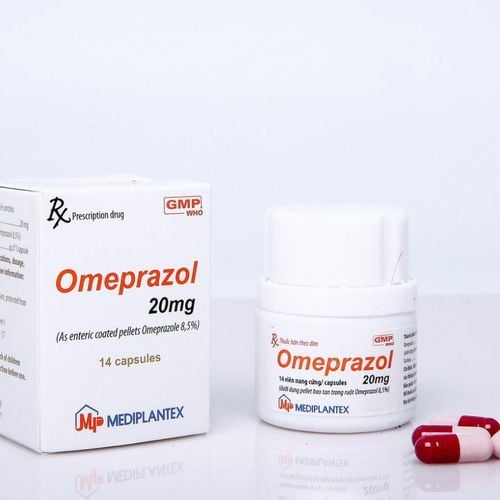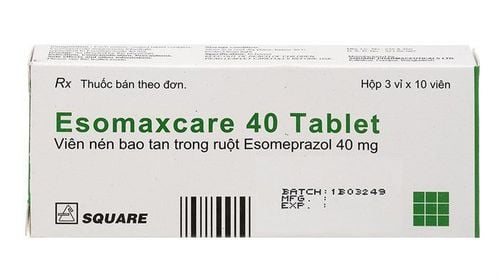This is an automatically translated article.
Meyerpanzol is a proton pump inhibitor, used in the treatment of reflux esophagitis, peptic ulcer, Zollinger-Ellison syndrome.
1. Uses of Meyerpanzole
Meyerpanzol drug has the main active ingredient is Pantoprazol, the drug is prepared in the form of enteric-soluble bam film tablets with a concentration of 40mg.
Pantoprazole is a proton pump inhibitor that is structurally and functionally similar to omeprazole. Pantoprazole is a benzimidazole with a substituent attached. Pantoprazole is protonated to the active form in the acid-secreting ducts of the parietal cells of the stomach, Pantoprazole inhibits the final stage of gastric acid formation by inhibiting the enzyme H+/K+ATPase also known as proton pump. This mechanism inhibits normal and stimulant gastric acid secretion.
Pantoprazol can inhibit Helicobacter pylori bacteria in patients with reflux esophagitis, peptic ulcer disease. Pantoprazol in combination with antibiotics in the treatment of H.pylori eradication, ulcer healing and long-term symptom relief.
2. Indications and contraindications to the drug Meyerpanzol
Meyerpanzol is indicated for use in adults and children 12 years of age and older in cases of reflux esophagitis.
In combination with appropriate antibiotic therapy for eradication of helicobacter pylori in patients with peptic ulcer disease. Stomach and duodenal ulcers. Zollinger-ellison syndrome and other hypersecretory conditions. The drug is contraindicated in the following cases:
Allergy or hypersensitivity to Pantoprazol or any component of the drug Meyerpanzol Patients with hypersensitivity to benzimidazole derivatives.
3. Dosage of Meyerpanzole
Meyerpanzol is taken orally, should be taken 1 hour before meals. Do not chew or crush the tablet to swallow. Below are the recommended dosages of Meyerpanzol
3.1. Reflux esophagitis Dosage 1 tablet / day. Depending on the case, the dose can be doubled: 2 tablets / day, especially when the patient has not responded to other treatments. The duration of treatment is 4 weeks, if the disease has not improved, it can be extended to use Meyerpanzol for another 4 weeks. 3.2. Meyerpanzol in combination with appropriate antibiotics to eradicate H. pylori Depending on the resistance of H.pylori, some of the following regimens can be applied
Regimen 1:
Pantoprazol 40mg x 2 times/day . Amoxicillin 1000mg x 2 times/day. Clarithromycin 500mg x 2 times/day. Regimen 2
Pantoprazol 40mg x 2 times / day. Metronidazole 400 - 500mg (or 500mg tinidazole) x 2 times / day. Clarithromycin 250 - 500mg x 2 times / day. Regimen 3
Pantoprazol 40mg x 2 times / day. Amoxicillin 1000mg x 2 times/day. Metronidazol 400 - 500mg (or 500mg Tinidazol) x 2 times / day. Pantoprazol tablets taken for the second time of the day should be taken 1 hour before the evening meal. The treatment period is 7 days and can be extended for another 7 days, for a total of two weeks. Pantoprazol may be additionally indicated for the treatment of peptic ulcers.
Treatment of stomach ulcers: Dosage 1 tablet / day. Depending on the case, the dose can be increased: 2 tablets / day. The duration of taking Meyerpanzol in the treatment of peptic ulcers is usually 4 weeks. If the disease does not improve, treatment can be extended for another 4 weeks.
3.3. Treatment of duodenal ulcer Dosage 1 tablet / day. Depending on the case, the dose can be increased: 2 tablets / day. The duration of treatment for duodenal ulcer is usually 2 weeks. If the disease does not improve, treatment can be extended for another 2 weeks.
3.4. Zollinger-ellison syndrome and other hypersecretory conditions Initial dose is 80 mg/day. If dose > 80mg/day, divide dose into 2 times/day. The duration of treatment is not limited, and the dose is adjusted according to the clinical condition of the patient.
3.5. Hepatic impairment Meyerpanzol should not be used in excess of 20 mg/day in patients with severe hepatic impairment. Pantoprazol should not be used in the treatment of H. pylori eradication in patients with moderate to severe hepatic impairment because there are currently no data on the efficacy and safety of using pantoprazole in combination therapy in these patients.
3.6. Renal impairment No dose adjustment of Meyerpanzol is required in patients with renal impairment. Pantoprazol should not be used in the treatment of H. pylori eradication in patients with renal impairment because there are currently no data on the efficacy and safety of using pantoprazole in combination therapy in these patients.
3.7. Children Meyerpanzol is not recommended for use in children under 12 years of age due to limited data on safety and efficacy in this population.
4. Notes when using Meyerpanzol
Liver failure: Monitor liver enzymes during treatment with Meyerpanzol in patients with severe hepatic impairment, especially taking the drug for a long time. Discontinue use when liver enzyme elevation occurs.
Affects absorption of vitamin B12 : Zollinger - Ellison syndrome and other hypersecretory conditions requiring long-term treatment, Pantoprazol may reduce vitamin B12 absorption. Monitor patients if the duration of Meyerpanzol administration is longer than 1 year.
Do not co-administer Meyerpanzol with HIV protease inhibitors whose absorption is pH dependent, such as Atazanavir, due to reduced bioavailability.
Gastrointestinal infections : Meyerpanzol use has a slightly increased risk of gastrointestinal infections compared with salmonella and campylobacter or c.difficile.
Severe hypomagnesaemia has been reported in some patients using proton pump inhibitors such as pantoprazole for at least three months and in most cases after one year of treatment. Symptoms of hypomagnesaemia usually improve after magnesium supplementation and discontinuation of proton pump inhibitors.
Patients taking Digoxin or other drugs that may cause hypomagnesaemia (e.g. diuretics): consider monitoring magnesium levels before starting proton pump inhibitor therapy and periodically during treatment.
Fractures: Long-term use of high doses of proton pump inhibitors for >1 year may moderately increase the risk of fractures of the pelvis, wrist, and spine, in the elderly or in patients with other risk factors. . Research shows that proton pump inhibitors can increase the risk of fractures by 10 to 40%. Patients at risk for osteoporosis should be provided with adequate vitamin D and calcium.
Subacute lupus erythematosus: cases of lupus erythematosus associated with proton pump inhibitors are very rare. If skin lesions appear, especially in sun-exposed areas accompanied by joint pain, stop taking Meyerpanzol and seek medical attention.
Ingredients Meyerpanzol contains lactose . Patients with certain medical conditions such as galactose intolerance, glucose-galactose malabsorption should not take Meyerpanzol.
Excipients of the drug Meyerpanzol: tartrazine yellow can cause allergic reactions, propylene glycol causes skin irritation.
Driving and using machines: Meyerpanzol has no significant influence on the ability to drive and use machines. If adverse reactions such as dizziness, visual disturbances occur: the patient should not drive or operate machinery. Pregnancy: Animal studies have shown that Pantoprazole has the potential to cause reproductive toxicity. Avoid using Pantoprazol in pregnant women.
Lactation: animal studies have shown that pantoprazole is excreted in human milk. The risk of the drug to the neonate cannot be excluded. Therefore, the decision to discontinue breast-feeding or to discontinue Meyerpanzol therapy should take into account the benefit of breastfeeding to the mother's use of Meyerpanzol.
5. Undesirable effects when using the drug Meyerpanzol
Psychiatry: Sleep disorders, depression. Hallucinations, confusion. Nervous system: headache, dizziness. Gastrointestinal: adenomatous polyps at the base of the stomach (benign), diarrhea, nausea, vomiting, flatulence, constipation, dry mouth, abdominal pain and discomfort. Skin and subcutaneous tissue: rash, itching. Urticaria, edema. Lyell syndrome, Stevens-Johnson syndrome, photosensitivity, erythema multiforme, subacute lupus erythematosus. Musculoskeletal and connective tissue: fractures of the pelvis, spine or wrist. Joint pain, muscle pain. Immune system: allergies, hypersensitivity, anaphylactic reactions and anaphylaxis. Metabolic and nutritional disorders: hyponatremia, hypomagnesaemia, hypocalcemia associated with hypomagnesemia. Increased lipids, triglycerides, cholesterol. Weakness, fatigue and irritability. Taste disorder. Visual disturbances/blurred vision. Large breasts in men.
6. Drug interactions
Drugs with pH-dependent pharmacokinetic absorption: because Meyerpanzol inhibits gastric acid secretion permanently and completely, the drug may affect the absorption of drugs whose gastric pH is a factor. important influence on the effectiveness of oral medications such as itraconazole, ketoconazole, posaconazole, and erlotinib. HIV protease inhibitors: Meyerpanzol should not be used concomitantly due to a significant decrease in its bioavailability. Where it is necessary to combine an HIV protease inhibitor with a proton pump inhibitor, close clinical monitoring is recommended. The dose of Meyerpanzol 20 mg daily should not be exceeded and the dose of HIV protease inhibitors may need to be adjusted. Coumarin anticoagulants (phenprocoumon or warfarin): There have been reports of increases in INR and prothrombin time in patients receiving proton pump inhibitors with warfarin or phenprocoumon. Methotrexate: Concomitant use of high doses with proton pump inhibitors has been reported to increase methotrexate concentrations in some patients. Therefore, temporary discontinuation of pantoprazole may be considered in patients receiving high doses of methotrexate. Fluvoxamine may increase the systemic exposure of pantoprazole. A dose reduction may be considered for patients on long-term treatment with high-dose pantoprazole or with hepatic impairment. Rifampicin: may decrease plasma concentrations of proton pump inhibitors.
Please dial HOTLINE for more information or register for an appointment HERE. Download MyVinmec app to make appointments faster and to manage your bookings easily.













